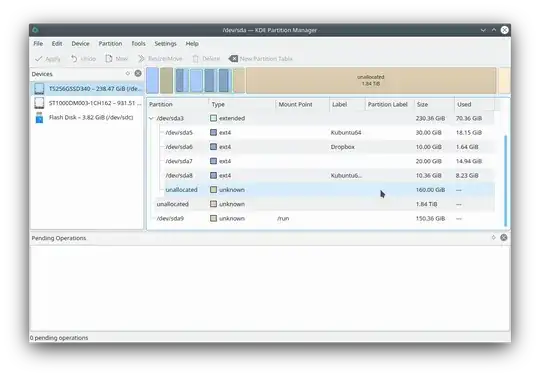I've been riding Ubuntu 16.04 down to the wire; with EOL now only four months off, I'm exploring options for replacement (since Linux apparently never will support real upgrades). One of the replacements I'm looking at is Kubuntu 20.04; I previously used Kubuntu 14.04, then switched DTE for 16.04.
Today, I was using the Kubuntu 20.04 Live "Try Ubuntu" option to do a job I couldn't do when running from my SSD: resize my /home partition. I've been getting "low space" messages for weeks what with downloads related to game updates and downloading Linux distro .iso files (each a couple gigabytes or more). Emptying the trash was no longer doing the job, and I had a partition immediately above (to the "left" of) my /home that was leftover from a trial install of Kubuntu 16.04. There were about 2 GB of free space in the 150+ GB /home partition.
Using the KDE Partition Manager on the 20.04 Live trial, I selected to shrink that old Kubuntu partition (which hasn't been used in years, may not even be bootable), move the /home into the freed space, and expand /home to fill the newly freed space at the end of the drive. Everything went smoothly for 45+ minutes while the partition geometry was set, the partition moved, and the geometry reset for the larger space -- but during "expand file system" I was informed that "errors occurred -- aborting". Now, my entire 150 GB /home partition is inaccessible. KDE Partition Manager now reports 160 GiB "unallocated" where my /home should be, 1.84 TiB unallocated space following it (on a 256 GB SSD), and 150.36 GiB (the size of my old /home) with mount point /run and outside the extended partition that it should be in.
I'm confident my data is still present -- the move operation had completed successfully -- but my 16.04 won't boot without /home. I'm not a CLI guru at all, but sudo fsck /dev/sda9 won't even admit that /sda9 exists (it's fine with the other partitions). This partition, like my others, is in ext4 format. At present, the only tools I have are those included on the Kubuntu 20.04 Live download. My old copy of Parted Magic is in the damaged partition, and I don't have a copy on my laptop. And I can't just restore from backup; despite the way things ought to be, backups for hundreds of gigabytes are neither easy nor free.
Most of the data in the partition are games, Wine prefixes for games, downloaded files (largely for games, but also Linux .iso files) -- but also in there are about 100,000 words of partial novels I haven't worked on lately but would very strongly prefer not to lose.
How can I repair this?
So far, I've attempted to use fsck -- which won't admit there's a partition there at all. KDE Partition manager reads out what I've told you -- I might be able to edit in a screenshot from the 20.04 Live session, but I doubt it'll gain anything. I have a working Firefox and wired connection to the Internet on the machine, but the USB isn't set up as persistent, so anything I install will vanish next restart. There's 1.43 GiB of "Writable" partition on the USB stick, but it's not being used for persistence and I don't know how to set it up to be so.
$ sudo blkid
/dev/sda1: LABEL="Boot" UUID="5244bd6b-56d2-4966-bc64-b5d145e681ec" TYPE="ext4" PARTUUID="000e3de9-01"
/dev/sda5: LABEL="Kubuntu64" UUID="b401b3f9-9dc6-4c3d-80fe-aabaf5f327cc" TYPE="ext4" PARTUUID="000e3de9-05"
/dev/sda6: LABEL="Dropbox" UUID="9ddd5013-36af-4d63-a492-710a4069af68" TYPE="ext4" PARTUUID="000e3de9-06"
/dev/sda7: UUID="8cd256cb-e942-425b-acce-e189f0bcf4c9" TYPE="ext4" PARTUUID="000e3de9-07"
/dev/sda8: LABEL="Kubuntu64 16.04" UUID="42b5719f-9dc4-4f92-88d2-c1ec48f25395" TYPE="ext4" PARTUUID="000e3de9-08"
/dev/sdb1: LABEL="Seagate 1T-C" UUID="5E5C65065C64D9F3" TYPE="ntfs" PARTUUID="8623c7fc-01"
/dev/sdb5: LABEL="Seagate 1T-D" UUID="88CCAB91CCAB77D8" TYPE="ntfs" PARTUUID="8623c7fc-05"
/dev/sdb6: LABEL="Seagate 1T-E" UUID="3680C08C80C05451" TYPE="ntfs" PARTUUID="8623c7fc-06"
/dev/sdb7: LABEL="Seagate 1T-F" UUID="E6ACC7B2ACC77B95" TYPE="ntfs" PARTUUID="8623c7fc-07"
/dev/sdb8: LABEL="Seagate 1T-G" UUID="48CCD912CCD8FB60" TYPE="ntfs" PARTUUID="8623c7fc-08"
/dev/sdb9: LABEL="Seagate 1T-H" UUID="CA58E44A58E436BB" TYPE="ntfs" PARTUUID="8623c7fc-09"
/dev/sdc1: UUID="2020-07-31-16-50-07-00" LABEL="Kubuntu 20.04.1 LTS amd64" TYPE="iso9660" PTUUID="7341469f" PTTYPE="dos" PARTUUID="7341469f-01"
/dev/loop0: TYPE="squashfs"
/dev/sda2: UUID="a7bf4f9c-f525-4646-87dd-f897cec03c66" TYPE="swap" PARTUUID="000e3de9-02"
/dev/sdc2: SEC_TYPE="msdos" UUID="C26E-047E" TYPE="vfat" PARTUUID="7341469f-02"
/dev/sdc3: LABEL="writable" UUID="e3579a86-3ecb-4ef0-a21d-983e5b417714" TYPE="ext4" PARTUUID="7341469f-03"
The /home should be /dev/sda9 -- I don't recall immediately whether it was labelled as "Home" or not.
Here's the exported partition table -- I'm afraid to edit this without coaching, but apparently KDE Partition manager can export and import it, so it's possible. As noted, the /home should have been in /sda9.
##|v1|## partition table of /dev/sda
# on Friday, 25 December 2020 22:16:46 UTC
type: "msdos"
align: "sector"
number start end type roles label flags
1;63;208844;ext4;primary;"Boot";"boot"
2;208845;16996769;linuxswap;primary;"";""
3;16996831;500103449;extended;extended;"";""
5;16996833;79907309;ext4;logical;"Kubuntu64";""
6;79907373;100888199;ext4;logical;"Dropbox";""
7;100888263;142833914;ext4;logical;"";""
8;142833978;164562943;ext4;logical;"Kubuntu64_16.04";""
9;4459532288;4774856044;unknown;primary;"";""
I think it should look like this:
##|v1|## partition table of /dev/sda
# on Friday, 25 December 2020 22:16:46 UTC
type: "msdos"
align: "sector"
number start end type roles label flags
1;63;208844;ext4;primary;"Boot";"boot"
2;208845;16996769;linuxswap;primary;"";""
3;16996831;500103449;extended;extended;"";""
5;16996833;79907309;ext4;logical;"Kubuntu64";""
6;79907373;100888199;ext4;logical;"Dropbox";""
7;100888263;142833914;ext4;logical;"";""
8;142833978;164562943;ext4;logical;"Kubuntu64_16.04";""
9;164562944;500321424;ext4;logical;"/home";""
However, while other devices have an option to import a partition table within KDE Partition Manager, that option is greyed out for this SSD ("Export partition table" is available, but not "Import partition table").
I have a working laptop with Unbuntu 16.04, and an external disk test device I can use to access the SSD outside the desktop machine if needed -- so I can use a fully installed 16.04 for the repair work if that's easier/better than the 20.04 Live session. And I have two more days of the weekend (I should be spending this time in my darkrooms, but this is kind of an emergency), with another four-day weekend over New Year's.
